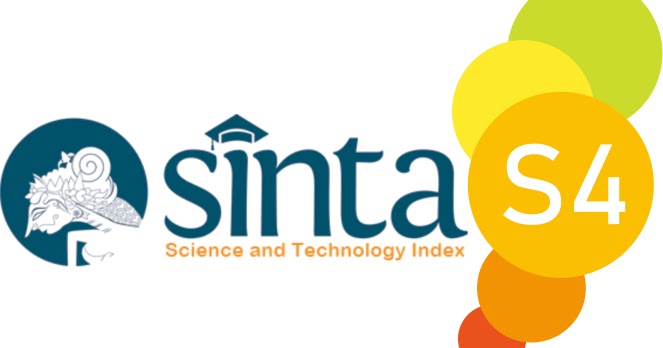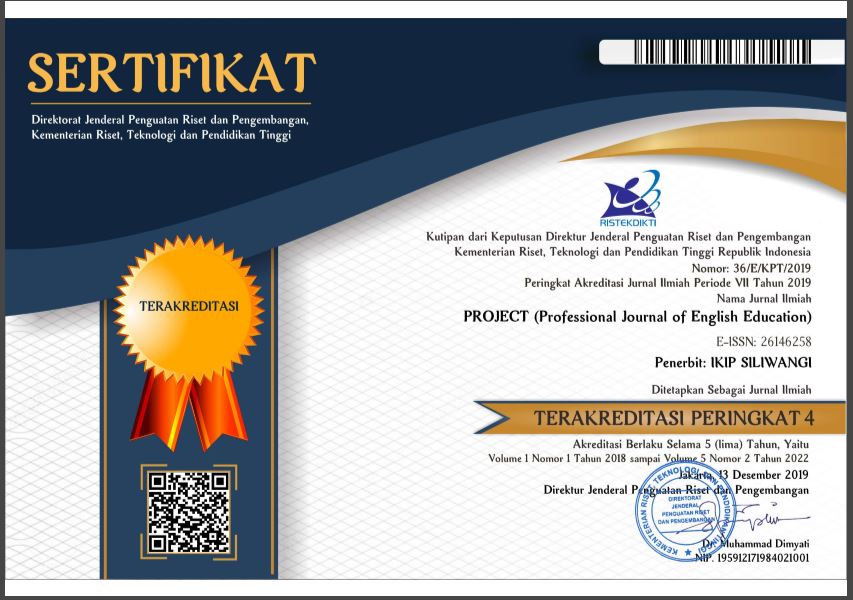Exploring Lexemic Idiomatic Expressions in Robert Their’s Wattpad Novel “Storm and Silence”
Abstract
This research explores the use of lexemic idiomatic expressions in Robert Thier's Wattpad novel "Storm and Silence" and their literal meanings. The research employs a descriptive qualitative method to identify and categorize idiomatic expressions within the text. This research uses semantics by using Makkai's theory. The data presented taken from Robert Thier's Wattpad novel Storm and Silence; 106 data were found. The result of this research is that tournure idioms are the most prevalent 48 (45%), followed by phrasal verb idioms 19 (18%) and phrasal compound idioms 14 (13%). Pseudo-idioms 11 (10%). Interestingly, the irreversible binomial idiom contains 8 (8%), whereas the incorporation verb is 6 (6%). The result highlight the significance of idiomatic expressions in enhancing character development and thematic depth while presenting challenges for readers unfamiliar with idiomatic expressions. This research contributes to understanding idiomatic expressions in contemporary literature, particularly on digital platforms like Wattpad. It raises awareness among readers regarding the cultural nuances embedded in idiomatic language. The research suggests that further research could expand the dataset and duration to enrich the analysis of idiomatic expressions across various literary genres.
References
Agoes, F. (2016). an Analysis of Translation of Idioms Used in Conan Doyle’S Novel “a Study in Scarlet.” Jurnal Bahasa Inggris Terapan, 2(2), 9–20. https://doi.org/10.35313/jbit.v2i2.1287
Amalia, M., Hilman, E. H., & Putri, E. J. (2021). Idiomatic Expressions in J.K. Rowling’s Harry Potter and The Prisoner of Azkaban. JL3T (Journal of Linguistics, Literature and Language Teaching), 7(2), 134–151. https://doi.org/10.32505/jl3t.v7i2.3276
Arly, M., & Hilman, E. H. (2023). Translation Analysis of Idiomatic Expression in the Amazing Spiderman Movie. 6(4), 723–728. https://www.subtitlist.com/subtitles/the-amazing-spider-man.
Bolinger, D., & Makkai, A. (1976). Idiom Structure in English. Language, 52(1), 238. https://doi.org/10.2307/413219
Carishma, S. S., Zahrida, Z., & Elfrida, E. (2022). An Analysis of Lexemic Idiomatic Expressions in Eaternal Nocturnal Webtoon. Wacana: Jurnal Penelitian Bahasa, Sastra Dan Pengajaran, 20(1), 37–45. https://doi.org/10.33369/jwacana.v20i1.22059
Diantri, D. N. I., Prabowo Kusumo, & Maria Yosephin. (2023). an Analysis of Idiomatic Expressions Used By Content Creators on Tiktok. Didaktik : Jurnal Ilmiah PGSD STKIP Subang, 9(04), 701–712. https://doi.org/10.36989/didaktik.v9i04.1645
Elfath, B. (2022). the Idiomatic Expressions Used By the Characters As Found in Megamind Movie. Nazharat: Jurnal Kebudayaan, 27(1), 33–46. https://doi.org/10.30631/nazharat.v27i1.53
Gulo, E. F. C., Tarigan, E. B., Laia, D. P. L., Manik, S., & Manurung, L. wahyuni. (2023). Analysis Of Strategies Used To Translate Idiomatic Sentences From Indonesian To English Found In Folklore’s Book Of Malin Kundang. Jurnal Pendidikan Dan Konseling (JPDK), 5(4), 456–464. https://doi.org/10.31004/jpdk.v5i4.17805
Mabruroh, K. (2015). An Analysis of Idioms and Their Problems Found in the Novel the Adventures of Tom Sawyer By Mark Twain. Rainbow: Journal of Literature, Linguistics and Cultural Studies, 4(1), 1–11. http://journal.unnes.ac.id/sju/index.php/rainbow
Marpaung, T. S., Pangaribuan, R. E., & Pasaribu, D. R. (2023). Harmonizing Linguistics with Melody: An Analysis of Lexemic Idioms in Taylor Swift’s “Evermore” and Their Pedagogical Implications for EFL. ELT Worldwide: Journal of English Language Teaching, 10(2), 393. https://doi.org/10.26858/eltww.v10i2.53617
Melati, W. A. (2019). the Translation Analysis of the Idiomatic Expression Used in the Novel " Confession of an Ugly Stepsister " By Gregory Maguire. 1(2), 92–97.
Melinda, S., Bertris, A., Hilman, E. H., & Putri, E. J. (2022). Idiomatic Expression Translation Strategies in Novel “ the Fault in Our Stars .” PROJECT (Professional Journal of English Education), 5(1), 133–143. https://www.journal.ikipsiliwangi.ac.id/index.php/project/article/view/8530
Nasir, C., & Ufairah, A. (2023). Idiomatic Expressions Used by the Acehnese Novelist Arafat Nur in the Novel Tanah Surga Merah. Studies in English Language and Education, 10(1), 537–555. https://doi.org/10.24815/siele.v10i1.26649
Oktaviani, L. and M. (2018). A STUDY OF IDIOMS FOUND IN FREEDOM WRITERS MOVIE Lely Oktaviani,. Prosodi, 12, 241–253. file:///C:/Users/asus/Downloads/4529-10798-1-PB.pdf
Robert C. Bogdan & Sari Knopp Biklen. (1982). Qualitative Research for Education: An Introduction to Theory and Methode.
Saputri, N. L., & Irfan Hadi, I. (2021). an Analysis of Idiom Expressions in Novel “Mary Poppins” By P.L. Travers. Jurnal Lentera Pendidikan Pusat Penelitian Lppm Um Metro, 6(1), 14. https://doi.org/10.24127/jlpp.v6i1.1615
Sinambela, E., Manik, S., Siregar, R., Manurung, L. W., & Saragi, C. N. (2023). An Analysis of Translation Strategies Used by Students in Translating Idioms at the Second Grade of SMA Kalam Kudus. International Journal of Membrane Science and Technology, 10(2), 550–557. https://doi.org/10.15379/ijmst.v10i2.1265
Sipayung, K. T., Pasaribu, A. N., & Sinaga, N. T. (2024). Common Problems and Overt Errors in Translating Idioms in The Film Maleficent. Eurasian Journal of Applied Linguistics, 10(2), 23–31. https://doi.org/10.32601/ejal.10203
Yalase, R. (2022). An Analysis of Idiomatic Expressions Found in Adele’s Selected Lyrics Songs. JournEEL (Journal of English Education and Literature), 4(2), 33–42. https://doi.org/10.51836/journeel.v4i2.358
Yulianti, R., Hilman, E. H., & Agustina, M. D. (2022). Translation Analysis of Idioms in Novel Crazy Rich Asians: Semantic Approach. IdeBahasa, 4(1), 67–78. https://doi.org/10.37296/idebahasa.v4i1.78
Yuliasari, R., & Virtianti, R. (2022). Idiom Expressions In “The Adventures Of Sherlock Holmes” Novel By Sir Arthur Conan Doyle. Multidisiplin Ilmu, 1(02), 51–58. https://journal.mediapublikasi.id/index.php/bullet
Downloads
Published
Issue
Section
License

This work is licensed under a Creative Commons Attribution-ShareAlike 4.0 International License.




